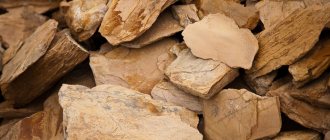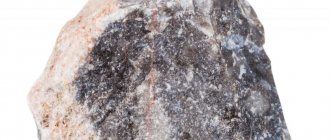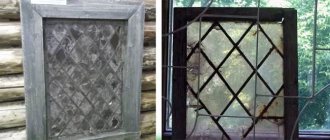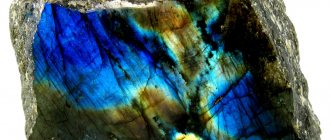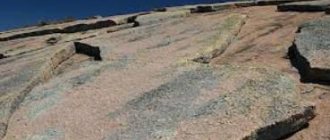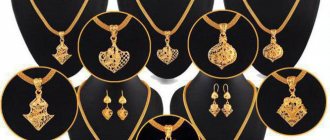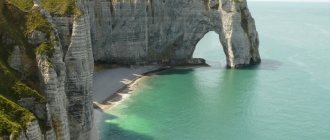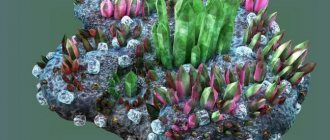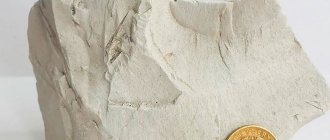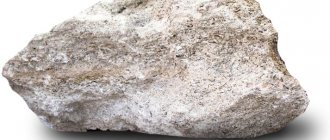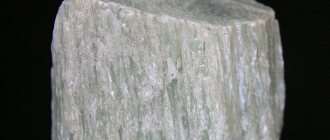History and origin
The history of man's use of stones of various types goes back thousands of years, because as soon as he began to recognize himself as a man, the need arose to build houses and roads, make dishes and jewelry. For this purpose, the hardest and most beautiful stones were used. One of these minerals was syenite - a massive, hard rock, similar in appearance to granite.
Mineral – Syenite
This stone began to be used in Ancient Greece. Near the city of Song, beautiful pinkish and gray stones were discovered that were perfect for building or lining houses and roads. C. Pliny then classified the mineral as a rock under the general name Siene. And several centuries after that, in Germany near the city of Dresden, G. Werner found similar stones and, based on ancient records and comparative analysis, gave it the name syenite.
In Russia, too, there are surprisingly interesting descriptions of syenite, left by Prince Kropotkin in the 19th century after a trip to Buryatia. He noticed that the mineral has a layered structure and alternates with granite.
Place of Birth
Nepheline stone makes up one percent of igneous rocks, but is distributed throughout the planet.
Deposits by continent:
- America: Brazil, Canada, USA;
- Asia: Kazakhstan, Kyrgyzstan, Uzbekistan;
- Africa: South Africa, Kenya, Uganda;
- Europe: Scandinavia, Greenland, Ukraine, Germany.
In Russia, the North (Kola Peninsula, Karelia) and the Asian part are rich in deposits: Transbaikalia, the Urals, and the environs of the Yenisei.
The largest active deposits of nepheline raw materials are in Canada (up to 650–710 thousand tons annually) and Norway (330–360). The rock is mined in quarries. It lies in layers, stocks or dikes.
Mineral mining
Syenite is often a companion of granite, and therefore it is usually found near its deposits - in the marginal zone - in the form of massifs and veins. The stone is classified as an igneous rock located deep underground, although, thanks to the ongoing internal life of the planet, it is now often found on the surface.
This breed is one of the most common on Earth and is found everywhere. Large deposits are located in North America (Arkansas and Wisconsin), Africa (South Africa, Kenya, Uganda), Brazil, Germany and the islands of Scandinavia.
In Russia, syenite deposits were discovered in the Trans-Baikal Territory, on the Yenisei Ridge and the Kola Peninsula. And in the Sayan Mountains there is a nature reserve called Krasnoyarsk Pillars. There, bizarrely shaped columns form an unearthly landscape. They are oddly shaped blocks stacked on top of each other.
Granite and stone
Formation of syenites, varieties, properties and applications
Syenites belong to a group of rocks that are often called granitoids.
In its mineralogical composition, syenite differs from granite only in that it contains a small amount of quartz (or does not contain it at all), which is externally expressed in the absence of the characteristic “granite shine”, which is caused by quartz crystals in granite samples. The name of the breed comes from the Greek name of the ancient Egyptian city of Song, which the Greeks called Syene - Siene. Syenite is an intrusive holocrystalline rock with a high content of feldspars (up to 90%) and dark-colored minerals (10-20%). In terms of silica content, syenites are classified as medium-sized rocks, differing from diorite in their higher alkali content.
Based on the alkali content, syenites are divided into three main groups: normal, high and high alkalinity (or alkaline syenites). Normal syenites are dominated by potassium feldspars, while alkali syenites contain only alkali feldspars. In addition to spars, syenite rocks contain hornblende, biotite, pyroxenes (augite, diopside), and plagioclases (oligoclase or andesine).
The origin of syenite rocks is associated with the formation of syenite magma, which arises as a result of cooling processes of melts of more basic or more acidic compositions. Form of occurrence - layers, dikes, stocks.
Chemical composition of normal syenites (average, in mass fractions): SiO2-58.65%; TiO2-0.86%; Al2O3-16.38%; Fe2O3-3.65%; FeO-3.09%; MnO-0.15%; MgO-3.06%; CaO-4.45%; Na2O-3.48%; K2O-4.79%; H2O-1.13%; Р2О5-0.31%.
The specific gravity (density) of different types of syenites varies from 2600 to 2750 kg/cubic meter. m. Compressive strength is significantly lower than that of granites - 150-300 MPa.
Syenites also include non-flin falspathoid rocks and a group of vein melanocratic rocks (lamprophyres). Nepheline syenite contains, along with potassium feldspar, grayish grains of nepheline, a mineral of the feldspathoid family.
Depending on the mineralogical composition of rocks, some types of syenites can be called transitional forms between other rocks of the granitoid group - diorites (syenodierites), gabbros (monzonites) and granites (granosyenites, or syenites with a high content of quartz).
The structure of syenites is uniform-grained: coarse-, medium-, fine-grained and porphyritic. The textures are massive. The color range of different species of this breed is wide - from pinkish to gray shades.
Syenite rocks are widespread in many areas of the planet. Large deposits are present in the USA (White Mountains, northern Wisconsin, Arkansas), Africa (South Africa, Kenya, Uganda), Brazil, and also in Europe (Scandinavian Peninsula, Germany). In Russia, the most significant deposits of syenite are found in the Urals, Transbaikalia and the Yenisei Ridge. Large deposits of alkaline and nepheline syenites are present in Karelia, on the Kola Peninsula.
The development of syenites is carried out using the quarry method. They are used in construction as crushed stone (in buildings and structures with low requirements for durability and strength), as well as for the production of glass and ceramics (as feldspar substitutes). The most important area of application of nepheline syenites is the production of alumina for the aluminum industry. Soda, cement and fertilizers for acidic soils are also obtained from syenites.
* * *
Main characteristics of labradorites
- Home LLC "Granit"
- Crushed stone and roads
- Foundations
- Characteristics of crushed stone
- Breed classification
- Crushers
- Fundamentals and history of geology
- Basics of geodesy
- Mineralogy and minerals
- Surveying business
Physicochemical characteristics
Syenite, an intrusive holocrystalline rock, was formed as a result of volcanic activity that continued on Earth for many thousands of years. The movement of magma and its constant replenishment with new minerals formed the interesting structure of the stone - a combination of small and large mineral grains of different colors - pink, gray, green and dark.
The rock is most often formed by feldspar, dark-colored minerals and silica. And the concentration of acidic minerals makes syenite an alkaline rock.
Also read: Tsavorite – the emerald green of Africa
| Property | Description |
| Hardness | 6 |
| Density | 2600 kg/m³ |
| Strength | 150-300 MPa |
| Brightness | 86% |
| Texture | Massive |
| Structure | Full-crystalline, uniformly crystalline, sometimes porphyritic, fine- and medium-grained |
| Mixing | Feldspar and dark-colored minerals |
| Form of occurrence | Dykes and rods |
| Genesis | Intrusive |
| Color | Light-colored rocks, grayish and pinkish, depending on the color of potassium feldspar and the content of dark-colored minerals |
Average chemical composition:
- SiO2 56-62%,
- TiO2 0.5-2%,
- Al2O3 14-19%,
- Fe2O3 1-4%,
- FeO 0.5-5%,
- MgO 0.2-3%,
- CaO 1-5.5%,
- Na2O 4-6.5%,
- K2O 4-9%.
Geologists often call the stone quartz-free granite due to the absence of the radiant mineral in its composition. This feature deprives the stone of its shine.
In general, syenite is very similar to granite, but it is more susceptible to weathering and has a lower strength level.
Syenite stone. Properties of syenite. Applications of syenite
Description and properties of syenite
Syenite is a fully crystalline, quartz-free rock of igneous origin. Syenite is related to granite, but in terms of external beauty it is significantly superior to it. Usually has a pink or gray color that remains unchanged in any light conditions. It has been known for a long time, back in ancient Egypt.
Since then it has been used in construction, in particular in finishing work. It is valued for its attractive external properties. The main part of its composition is feldspars, and the remaining percentage is allocated to dark-colored minerals. The presence of silica classifies it as a medium-order rock. But unlike diorite, it is much more alkaline.
The concentration of alkali determines its group: medium-alkaline, subalkaline and simply alkaline. In terms of properties, granite is closest to it . Syenite is more prone to weathering than granite. The rock fraction may have small, large or porphyritic grains. The material is predominantly of a massive nature, sometimes fluid. The mineral includes feldspars and biotites, pyroxenes and plagioclases (oligoclase and andesine).
It also contains minerals of the accessory group - these are magnetites and zircons, apatites and ilmenites, and other sphenes. But this applies only to the medium-alkaline group, the rest are limited only by the content of feldspar. Of the dark-colored minerals, alkaline amphiboles can be noted. These are riebeckite and hastingsite, as well as barkevikite.
They also include pyroxenes such as aegirine. It is worth highlighting nepheline syenite, the composition of which classifies it as felspathoid rocks. Accordingly, the mineral belongs to the melancratic rock type. Such breeds are called laprophyres. In terms of silicic acid content, syenite comes after granite , diorite closes the chain. In terms of total alkalinity, syenite surpasses both of them.
Nepheline syenite
The mineral contains nepheline and feldspar in equal parts. There are also admixtures of pyroxene and biotite. The presence of other amphiboles from the alkaline discharge cannot be excluded. The impurity content can amount to a third of the total volume. In addition to nepheline syenite, the rock contains accessory type minerals. These are titanite and lamprophyllite, as well as enigmatite. There are also rarer elements.
The color of the stone depends on the other minerals present in the rock and its own characteristics. It can range from gray to greenish. Nepheline syenites have an extensive classification. These are miaskites - containing ferruginous biotite, rischorts - with a yellow-greenish tint, foyatites - with a large structure, having a light gray tint, and luavrites - with a green-black color palette.
Syenite – porphyry
The mineral is a rock of vein or subvolcanic origin, containing large crystals of spar and pyroxene of the monoclinic type. It has a trachyte structure and a gray with a brown tint color.
Syenite deposits and mining
More often the mineral can be found in the border zones of granite massifs and various stocks and veins. The syenite rock of the alkaline and calcareous type forms the so-called laccoliths or is represented by the edge line of the massifs consisting of nepheline type syenite. Syenite is formed due to the crystallization process of igneous rocks with a low silicon content. Syenite is a fairly common mineral.
Its deposits are scattered throughout the planet. These are the United States (Wisconsin, Arkansas), Africa (Kenya, Uganda), as well as Scandinavia and Germany. There are also large deposits in Russia. These are Transbaikalia and the Urals, Karelia and the Kola Peninsula, etc.
Applications of syenite
The properties and physical characteristics of the mineral allow it to be used in many industries. Their advantage is that there is no need for complex pre-cleaning of the material, limiting oneself to relatively simple manipulations. This makes their use economical and expedient.
Syenite, which is used in such areas as glass production, leather and textile industries, fully justifies the trust. It is actively used by enterprises specializing in wood and paper processing, as well as agriculture. The composition of nepheline syenites is as close as possible to the composition of various glass and ceramic products. This is due to the content of special oxides that promote the formation of glass.
By processing syenite, a chemical solution is produced, the so-called “sol”. The composition is obtained by appropriate processing of nepheline syenite, which in this case has clear advantages over, for example, feldspar. This is due to its relatively more active solubility in weak acids.
The solution interacts extremely intensively with the protein compounds that make up the animal dermis. Therefore, it is successfully used in tanning animal skins. Dressing using such a solution allows you to obtain leather products of the highest quality.
Application of syenite in the agricultural industry
Some types of syenites are used as fertilizers with a chlorine-free, potassium composition. They do not require special preparation before being applied to the soil. They are significantly different from feldspar, eliminating excessive soil acidity without harming the plantings. When applied, especially to calcareous soil, lime begins to displace potassium, and plants absorb it productively. It has been proven that after applying such fertilizers to the soil. Productivity increases significantly.
Quite expensive potassium alkali is successfully produced from such rocks. The simplicity of the method lies in their ability to react with lime. In addition, silicate glue, alum, and silica gel are produced from nepheline syenite. A solution of nepheline syenite has properties that protect surfaces during impregnation from water and fire.
The use of nepheline syenite to produce foam glass has long established itself as a proven practice. Syenite stone whose hardness allows it to be used in the construction field, is mainly mined from quarries. The resulting product is widely used in the construction of various construction projects and highways.
The final foam glass product can be of a block type, as well as the type of granules and segments. The production is waste-free; all residues from the manufacturing process of this building material are used as backfill for the thermal insulation layer.
Syenite, the use of which in construction is determined by its appearance and internal qualities, is quite popular in this area. It is used for interior and exterior decoration of walls, floors, facades and plinths. Paving steps, paths and platforms. Finishing of architectural objects (pedestals, fountains, tombstones, etc.)
Syenite price
can buy nepheline syenite (or rather nepheline powder) for $350 per ton. Prices for finishing materials depend on the quality of raw materials. Wholesale prices for the product also depend on trends in the global finishing stone market.
Types of stone
Depending on the mineralogical composition, syenites are divided into types:
- Syenodierites (Diorites) are greenish-gray, medium-grained, speckled structure, in which all minerals are clearly visible: magnetite, ilmenite, apatite, common hornblende. This massive stone is used in construction due to its characteristics: high hardness, non-fragility, strength (it can only be cut with a diamond).
- Monzonites (Gabbro) are black, dark green, spotted, smooth, evenly granular in structure, rich in plagioclase, quartz, chromite and apatite. Gabbro is similar to diorite, but has a dark color. Used for the production of high-strength facing and building stones.
- Syenite - porphyry - gray, brown, containing large spar crystals, with a trachyte structure.
- Nepheline syenites are white, grayish, reddish and greenish, closely resembling granite with many components: potassium feldspar, granular nepheline, titanium, enigmatite, chlorine, fluorine, phosphorus and non-ferrous metals that determine the color of the stone. It is an alkaline intrusive rock.
The complex fluctuating composition of nepheline syenite determined the appearance of several types of this mineral:
- Khibinites. They occur in the Khibiny Mountains and have a complex coarse-grained structure.
Khibinit - Foyaites. A breed with large grains on a light gray background.
Foyait - Miaskites. A mineral with a wide range of colors: from gray to pink and dark gray. It contains zircon, corundum and garnets, which gives the impression that shine emanates through the thickness of the stone.
Miaskit - Rischorrites. Thanks to biotite, the stones have a noble color: from deep green to gray ocher.
- Luyavrites. Due to its oversaturation with alkalis, it has a black-green color and a banded structure.
Luyavrit
When weathered, nepheline syenite acquires a blue glow.
Mineral composition
The quantitative ratios of the minerals that form a rock can fluctuate, leading to the existence of a large number of varieties. In general, the mineral composition of nepheline syenite is as follows:
- Feldspars (potassium) – orthoclase or microcline – from 65 to 70%;
- Feldspathoids – nepheline – about 20%;
- Colored minerals (mainly alkali pyroxenes, amphiboles, biotite lepidomelane) - from 10 to 15%.
Feldspathoids, including nepheline, are close in chemical composition to feldspars, but differ from them by a significantly lower content of silica SiO2.
Colored minerals are mainly represented by alkali pyroxenes and amphiboles; ferruginous biotite may be present. Sphene, apatite, zircon, perovskite and others are accessory (“additional”, which do not affect the classification of the rock) minerals, the content of which in this type of rock is very significant.
Scope of application of the mineral
All types of syenite are in demand by people in different areas of life, because the cost of processing them is minimal.
- Nepheline syenite, which in geology belongs to the group of framework silicates, is used
- Construction : as crushed stone for paths and areas near houses, internal and external cladding of houses, plinths, balconies, floors; in the production of anti-corrosion coatings for reinforced concrete structures.
- Chemical industry : in the production of cement, soda, alkali, glue, gels, paper and leather. Since the 30s of the 20th century, it has been widely used as a raw material for the production of alumina, necessary in the production of aluminum. It is classified as non-waste, because by-products: soda and sludge are used in the production of cement and silicate products, in the glass and ceramic industries. Modern technology makes it possible to simultaneously isolate rare chemical elements: gallium, rubidium and cesium.
- Agriculture : as part of highly effective fertilizers for acidic soils. Such fertilizers are created on the basis of potassium and without chlorine. They are absolutely harmless to soil, plants and humans. They reduce acidity, displace potassium and create conditions for plants to quickly absorb nutrients.
- Decorative purposes : for making sculptures, decorating fountains, stairs, making boxes, photo frames, writing sets
- Diorite, due to its color and structure, is used for the production of tabletops, pedestals, sculptures, steles, and monuments.
- Gabbro is used in construction in the form of stone tiles, crushed stone, chips, high-strength facing material, as a raw material for stone casting and in the production of mineral wool.
- Porphyry is one of the most durable rocks. They are a quarter harder than granite. This quality is used in construction and cladding. Cladding tiles or paving stones made from porphyry last 14-15 years, which is twice as long as granite tiles. Due to its high wear resistance, it is not afraid of impacts, sharp heels and scratches. And its low thermal conductivity makes it an excellent thermal insulation finishing natural material. Porphyry has the amazing property of self-cleaning. It allows the use of this mineral as a floor covering in factories and gas stations, in auto repair shops and car dealerships, where floor contamination with difficult-to-remove substances of oil origin is inevitable. The spots will disappear in 2-3 weeks. The production of facing slabs does not require additional processing, since the cut stone has a pattern created by nature itself.
Nepheline Syenite
The use of porphyry for decorative purposes is due to the natural beauty of the pattern and is used in the decoration of ceilings and swimming pools. Ceiling tiles made from this mineral can create the effect of ancient Roman buildings. The stone is beautifully painted, taking on any color.
Areas of use
All nepheline-containing syenites are important minerals and are used in a wide variety of industries.
Rocks with a small amount of dark-colored minerals are used in ceramic and glass production. Due to the highly alkaline properties of nepheline, this rock is an excellent raw material for special compounds used in the leather, textile and woodworking industries. The large percentage of potassium in syenite allows it to be used for the production of fertilizers that can deoxidize soils.
Nepheline and feldspar are rich in aluminum. If the oxide content of this metal in the rock reaches more than 23%, such syenite is an aluminum ore.
Nepheline syenite is used in the production of self-cleaning anti-corrosion coatings for steel and concrete structures. And, of course, thanks to its high strength and good aesthetic qualities, it serves as an excellent facing material and is very widely used in construction and finishing works.
Medicinal properties
Syenite is a product of the planet’s volcanic activity, which has accumulated earthly energy over millions of years. He is able to carry out constant energy exchange with a person. This helps to harmonize your internal state and establish peace of mind and balance.
The stone is widely used in Chinese and Tibetan medicine as a biostimulator on biologically active points of the body. And in Indian Ayurveda, small, smooth, round-shaped syenites relieve pain of various natures and localizations.
The stone has also found its use in traditional medicine. Polished gabbro is used during massage procedures. In spa salons, massage with a mineral heated to room temperature has a relaxing and restorative effect.
In folk medicine, it is believed that yellow and gray nepheline syenites have a beneficial effect on the gastrointestinal tract and increase appetite, while green and gray ones normalize the functioning of the nervous system and improve vision.
Types of stone
The complex, fluctuating mineralogical composition resulted in the presence of nepheline syenite species.
There are several main ones:
- Luyavrites . Blackish-greenish specimens are maximally oversaturated with alkalis. The texture of this variety of syenite is trachytoid or banded.
- Rischorrites. Greenish or ocher-gray coarse-grained rocks with biotite in their composition.
- Foyaites. Light gray, coarse-grained.
- Miaskites. The color range is from light gray to pink and dark gray; accessory minerals include zircon, garnet, and corundum.
- Khibinites. Coarse-grained aegirine, named after its location (Khibiny in the Russian North).
In total, among the nepheline syenites, several dozen independent names for this rock have been identified.
Varieties
- biotite-hornblende;
- augite syenite;
- diopside (groebaite);
- hypersthenic, enstatite, andradite;
- hornblende (plauenite);
- corundum;
- corundum-mica;
- olivine;
- olivine-pyroxene, etc.
Magic properties
The stone is widely used in clairvoyance and extrasensory perception as a talisman. It reveals talent, increases abilities, helps expand the boundaries of the world around us, is effective in the hands of students, as it is able to help everyone who is drawn to something new, to discoveries, to knowledge of the Universe and its laws.
As an amulet, the mineral is protection against rash actions and hostile actions from the outside. Many astrologers claim that for Taurus and Aries, a small syenite placed above the entrance to the house will protect them from the evil eye and bad thoughts and create an atmosphere of love and prosperity.
Distance Learning Olympiad in Geography 2003Virtual library of stones.
Syenite
Compound
: similar in appearance to granite, but containing little or no quartz (less than 5%; rock with 5 - 10% quartz - quartz syenite).
The structure is coarse- to fine-grained, often even-grained, sometimes porphyritic. The main rock-forming minerals are potassium feldspar (usually microcline-perthite) and, in smaller quantities, plagioclase; dark-colored (hornblende, biotite and sometimes pyroxene, most often augite) total from 24 to 30-35%.
Common accessory and ore minerals are apatite, titanomagnetite, magnetite, ilmenite, titanite, zircon.
Alkaline syenites do not contain nepheline or other feldspathoids, but they contain alkali pyroxenes and/or amphiboles (arfvedsonite, riebeckite), and oligoclase gives way to albite.
Genetic classification
: igneous intrusive (deep) rock
Physical properties
:
Color pink, pinkish-gray or gray (depending on the color of the potassium feldspar and the content of dark-colored minerals).
Origin
: Syenites and nepheline syenites often occur in the form of large intrusive bodies (plutons, massifs). Alkaline and calc-alkaline syenites often form small massifs (stocks, etc.). Nepheline syenites can form small bodies.
Place of Birth
. In the USA, syenite rocks are developed in the White Mountains (New Hampshire), in the northern part of Wisconsin, south and west of Little Rock (Arkansas). In Europe, syenite outcrops in the vicinity of Oslo (Norway) and Dresden (Germany) are especially famous.
The most famous areas of distribution of syenites in Russia are the Urals, the Yenisei Ridge, Transbaikalia, and alkaline syenites are the Kola Peninsula. Nepheline syenites are widely developed in the Karelo-Kola region (Khibiny mountains, Lovozero tundra), in the Urals (Ilmen and Cherry mountains), in the northern Baikal region, Eastern Sayan, Kuznetsk Alatau, in the Sengilen mountains (southeastern Tuva), in Aldan and the north Krasnoyarsk region.
In Ukraine they are found in the Azov region (Mariupol massif), in Kazakhstan in the Ishim region. Nepheline syenites are widespread in southern Scandinavia, Finland, Greenland, Canada, Brazil, South Africa, East Africa (Kenya, Uganda, etc.).
Application
: Syenites are mined in small quantities by quarries, and they are marketed under the brand name granites. Nepheline syenites are particularly used as feldspar substitutes in the production of glass and ceramics. For this purpose, nepheline syenites are being mined in the province of Ontario (Canada).
The most important area of industrial use of nepheline syenites, the richest in nepheline, i.e. with high Al2O3 content, production of alumina; Such rocks represent the main type of non-bauxite raw material for the aluminum industry. Along the way, when processing them, soda, cement and fertilizers for acidic soils are obtained.
Nepheline syenites in Russia are associated with the largest deposits of apatite (Khibiny), rare metals (Lovozero tundra), as well as alumina raw materials (Kiya-Shaltyr in Kuznetsk Alatau).
Interesting Facts
: The quote below seems interesting to us from the point of view of a historian and local historian:
“News of the West Siberian Geological Exploration Trust, volume XII, issue. 2, Executive editor prof. M.A. Usov Geology of the region of Krasnoyarsk (Report on a 10-verst geological survey of 1929) Yu. A. KUZNETSOVA Tomsk, 1932, 46 pp.”
Alkaline syenites - effusives are cut in many places by a number of fairly large stocks of syenites, which, upon careful study, reveal an undoubted genetic connection with the most recent products of volcanic activity - orthophyres. It is these syenites that make up the famous Krasnoyarsk “Pillars”
In contrast to the syenite-diorite intrusion, syenites are very monotonous and uniform in composition, and differences that differ in any way from the usual ones appear relatively rarely among them. In a typical form, these are yellowish-gray in a fresh state, and in a more weathered state, they are pinkish-red and meat-red rocks, usually coarse-grained, even-grained or porphyritic with a characteristic miarolite texture, due to the presence of which they turn out to be extremely loose and, when weathered, easily crumble into wood.
In the specimens the rock appears to consist chiefly of grayish or red feldspar, appearing in the form of well-defined tablets, in the interstices between which are sometimes seated well-formed crystals of quartz. Biotite is present in relatively small quantities. hornblende and pyroxene.
When studying our rocks under a microscope, the first thing that stands out is the original character of the alkali feldspar. Relatively rarely, it is represented by fresh transparent and completely homogeneous grains, clearly monoclinic, but with a slightly different orientation from orthoclase: ANp = 13 -14 and 2v ranges from 60 to 84. In such homogeneous grains, a very subtle graceful zoiarity is often noticed.
More often, such homogeneous grains extinguish somewhat unevenly and, in places, they contain a very thin microcline lattice; such grains are already clearly triclinic: 7 (001) forms an angle of 13 with Nm, Np-78, Ng-80; 2v is very constant and equal to (-) 85.
Even more often, feldspar grains turn out to be highly pertitic; Why is pertitization captured either only the marginal parts of the grains or all the grains as a whole? In perthites, the albite component, having a composition of plagioclase 7, is almost twice that of orthoclase, and such formations deserve the name antiperthite. It is interesting to note that in syenites containing monoclinic feldspar, which can be called cryptoperthite, plagioclase is never found.
Syenites with triclinic alkali feldspar, which has all the properties and, as we will see below, the composition of anorthoclase, sometimes contain an extremely insignificant admixture of acid oligoclase. In addition, such anorthoclase varieties of syenites sometimes completely imperceptibly transform into oligoclase rocks.
Thus, it is very clearly seen here that the triclinic properties of anorthoclase are determined by the high content of albite and anorthite molecules, which is in full accordance with Focht’s view of the relationship of the orthoclase-albite-anorthite system.
The alkali feldspar content reaches at least 80/o, and sometimes more. The rest of the rock mass is represented by quartz, highly decomposed and browned biotite, uralitic hornblende, rare diopside, in one case arfvedsonite, a fairly significant amount of magnetite, titanite and apatite.
Among the structural features, the sharp idiomorphism of alkali feldspar is very characteristic; quartz always fills the spaces between the feldspar grains, and the dark-colored components are always heavily corroded by the latter.
Granite porphyry
- igneous rock
Color
. Grey, dark grey, yellowish, reddish or brick red.
Compound
. The main components are quartz, potassium feldspar (orthoclase) and mica. Phenocrysts of light minerals are represented mainly by feldspar, less commonly quartz, and dark-colored biotite. Granite porphyries can be significantly altered and contain secondary chlorite, serpentine, sericite, kaolinite and other minerals.
Structure
. The rock has massive and porphyritic structures. The groundmass is fine-grained and does not contain volcanic glass.
Origin
. The vein rock corresponds in composition to granite magma. It composes veins in the marginal parts of granite massifs.
Syenite porphyry
- igneous rock
Color
. Yellowish-gray, greenish, reddish or bluish.
Compound
. The main components of the rock are potassium feldspar (there is more of it than acid plagioclase), biotite and amphibole. Pyroxene (diopside augite) is present in smaller quantities. Phenocrysts are represented by feldspar and biotite, less commonly amphibole and pyroxene.
Structure
. The rock has a massive and porphyritic texture with a fine-grained, almost dense groundmass. Forms veins or composes the marginal parts of syenite bodies.
Origin.
The rock corresponds to syenite magma and is its vein analogue.
Syenite
(Great Russian Encyclopedia)
Name
stone from Syene - Syene, the Greek name for the ancient Egyptian city of Song, now Aswan)
Genetic classification
holocrystalline igneous rock
Composition
: mainly potassium feldspar, plagioclase, with an admixture of colored minerals: hornblende, biotite, pyroxene, and occasionally olivine. Quartz is sometimes present. Depending on the content of colored minerals, syenite is called hornblende, mica, quartz, etc.
Chemically, syenite is characterized by a silica content of 55 to 65%, and according to the alkali content they are divided into normal and alkaline. In normal syenites, plagioclases are represented by oligoclase and andesine; Alkaline syenites contain potassium feldspars and, less commonly, albite.
When the alkali content exceeds 12% and the silica content in the rock decreases, nephelines (or other feldspathoids—leucite, a sodalite group of minerals) are formed; alkaline syenites transform into nepheline syenites or other feldspathoid syenites. Close to syenites are monzonites or gabbro-syenites, consisting of labradorite and orthoclase with an admixture of colored minerals (pyroxene).
Distributed in southern Ukraine (Volyn region), in the Urals, as well as in Kazakhstan, the Caucasus, and Central Asia (monzonites).
Application
. Syenites are used similarly to granites.
A source of information
: materials are kindly displayed on the websites of the Around the World Encyclopedia, the unofficial server of the Geological Faculty of Moscow State University (the Key to the identification of minerals and rocks is very interesting - author Nemets F.), photographs by Sokolenko
Gift from team id 053, Zelenogorsk, Krasnoyarsk Territory
List of stones
Interesting things about the stone
- The world-famous sphinxes on the University Embankment in St. Petersburg are carved from syenite and are about three and a half thousand years old.
- Krasnoyarsk pillars made of pink syenite “grew” on the body of a huge monolith. Many millions of years ago, during violent magmatic activity, molten magma was able to break through cracks in it and froze on the surface, forming a magical picture.
Syenite cannot be classified as a precious stone. It is not used in expensive jewelry. But its value lies elsewhere: it was and will remain a symbol of the eternity and inviolability of Nature, reminiscent of the fragility and insecurity of man.
5 / 5 ( 1 voice )
Gabbro
(sheet 3, fig. 2) is a gray to black plutonic rock consisting predominantly of plagioclase and dark minerals.
The compressive strength is about 2000 kg/cm2 for fine-grained varieties and about 1000 kg/cm2 for coarse-grained varieties. Hardness on the Mohs scale is about 6. Solidity: the largest block size is about 4.0 m3.
- photo of gabbro stone
Scope of application: used similarly to previous hardwoods; used for cladding columns in the new building of the library named after V. I. Lenin in Moscow, in the mausoleum of V. I. Lenin, and also as a material for the pedestal of the monument to A. S. Pushkin in Moscow, etc. The black color of polished gabbro, approaching the color labradorites, allows it to be used along with the latter.
The sharp contrast between the color of the polished surface (black) and the impact (gray) makes gabbro especially suitable for applying ornaments and inscriptions.
